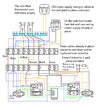I can see two motorised valves
but from picture can't work out how connected. To have a Hive two channel and single channel I would have expected three motorised valves, but the levers on the valves
will go slack when activated, so you can work out what does what.
In the main the thermostat/programmer works the valves, and valves work the boiler, and there are micro switches inside the valves which have been known to fail or stick. So if it did work, and then stopped would be looking at motorised valves.
I am an electrician not a plumber, and I have needed to sit down and draw out plans in the past to see how the system works, my own house is something like this

which took some doing, but now much easier to fault find as even though I rewired it, 2 years latter hard to remember what I had done, you need some thing similar for your system.
When I moved in here, found to turn central heating on, I needed to go outside walk around the house down a set of steps into the flat under the house, and plug in the central heating pump. There was a lovely sticker saying call this number for boiler service, and this one for electricians, both numbers clearly went into the black list, why any firm would admit they had wired it I don't know? Heath Robinson had nothing on this bunch, I wonder if that's why they sold the house?
But people seem to think a plumber or electrician will know how all water is connected and how all electrical systems are connected, this is not true, if you want a heating system installed you ask a heating and ventilation engineer, not a plumber, the plumbing trade is all about how to work with lead, so the church roof etc, is as much their job as fitting a tap, OK may not be in lead any more, but they do the jobs which a real plumber would have done in the past.
Pipe fitter is very different, working often with steel pipes 36" diameter, they need to cut, and grind them so when the crane lifts them into place, they fit first time, very skilled, they may also work with smaller pipes, where they don't need a crane, but each trade has a range of jobs they do, and asking a kitchen fitter to do electrics, or a plumber to fit boilers, they may be able to do the job, but are not always trained to do it.
Boilers are a trade of their own, although in the home the last thing we want is for the boiler to actually boil water. Why we still call them boilers I don't know.
But I walk into a house, and think what was in the mind of the guy who fitted this? Or designed this? When Drayton make a three zone programmer/thermostat, why would anyone fit a two zone and single zone Hive?
OK I made a mistake in hind sight fitting Nest Gen 3, but I am an electrician not a heating and ventilation engineer. So when Energenie TRV's said they worked with Nest I believed it.



